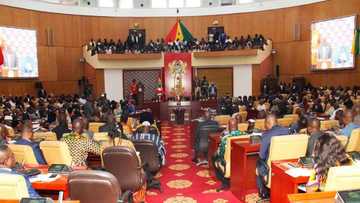Single Spine Salary Structure levels for teachers
If you are a Ghanaian, you probably have heard about the single spine salary structure (SSS). In this particular piece we will look at the Single Spine Salary Structure levels for teachers. The salary structure was introduced for public workers and it is also included in the teaching service. If you are curious about the Single Spine Salary structure and what it entails, especially in the teachers service, you are in the right place.

What is the Single Spine Salary structure?
The Single Spine Salary structure is a system that came to replace the Ghana Universal Salary Structure (GUSS) in 2010. It completely came to overhaul the pay structure that was being used to pay workers in the public sectors.
As it is well known, employment is a key factor for the growth and development of any country. To sustain a good employee portfolio, it is important to reward them for their efforts. The reward is presented to them as salaries. Sometimes, employees are rewarded through pay rises if they have achieved a certain milestone. A satisfied worker is one who receives their dues for the work they have done, but what does this have to do with the Single Spine Structure?
The Single Spine Salary Structure levels were introduced to remedy the problem of employees who are not satisfied. In Ghana, it was evident that having dissatisfied workers created a huge problem. It led to Ghana losing its work force to foreign countries. The wages being received by the workers continued to decline and they opted to forgo work in Ghana and travel abroad for work. The Single Spine Salary structure levels of pay is based on the Spine Pay Policy that is based on a system of awarding workers based on different levels of pay depending on the worker's level of qualification. It also rewards according to the experience of the worker and the type of tasks they perform.

You should however know that the Ghanaian idea of a Single Spine Salary structure is not completely the same as the orthodox spine pay structure. This is because the original single spine structure offers the same grade for all workers. In Ghana, the structure is used by different sectors of the civil service and therefore they have to use different grades for different individuals who meet the qualification requirements of the different careers. The Single Spine Salary Structure (SSS) includes, among others, workers in the education sector. So, you will discover that the Ghana education service pay structure have their special grading system from all the other sectors incorporated in the system.
Why was the Single Spine Salary Structure method adopted?
The single spine has several advantages. These are the reasons that led to the adaptation of the single spine salary structure method.
There were several instances of malicious pay negotiations between the government and the trade unions in Ghana. The public sector in Ghana has several divisions under the large umbrella of the public service. Each of these divisions has trade unions representing them. It was a regular practice of the trade unions to go to the government and try to negotiate pay rises for their clients severally in one year. They used to engage in some sort of superiority contest where each trade union negotiated for pay increases against the pay rise negotiated for by another trade union and the government. This structure is useful as it sets the minimum wage requirements as per agreed upon by the government and the trade unions. The rest of the talks are service-based.
The work force was very relaxed. There was little or no competition when it comes to the pay awarded to the workers. This was due to the fact salaries were not awarded according to merit. Every time a pay rise was negotiated, it was purely for gain of all workers regardless of their qualifications or eligibility for a rise in pay. In this new pay system, pay rise will be given purely on merit and not just after mere negotiations. Even during negotiations, it is only the people who are eligible for pay rise who are going to benefit.

READ ALSO: School in Ghana charges $30k for KG admissions and YEN.com.gh has photos of its plush compound
There was a large disparity in the salaries offered for the workers in the public service. The Single Spine Salary Structure looks to harmonize the salaries awarded to the various classes of workers. It aims to raise the salaries of the middle level earners who receive lower salaries but have equal level of qualification with the already high paid middle level earners. However, the middle income earners who are paid high wages see their wages stagnate until they are promoted to a higher rank or status in the profession.
Another issue that might be said to have been considered is the wage bill. Payroll irregularities were the major reason for this. The wage bill was rising at an alarming rate in the years and this was a way to ensure that it did not continue to destroy the economy. In an effort to stabilize the wage bill, they are using this to ensure that the salaries paid are harmonized. It is important to note that the Ghana Education Service and the Ministry of Education in Ghana were the ones who registered the highest payroll irregularities before the implementation of the SSS according to a World Bank report.
Pay is now given according to the value of the worker. It is awarded according to productivity of the worker.
Ghana Education Service and the Spine Salary Structure
In 2011, the move to the Single Spine Salary Structure for teachers in the Ghana education service was completed. However, this did not go so well with the teachers.
The Single Spine Salary Structure for teachers was faulted by the affected teachers in 2011 since the process was full of technical errors which led to wrong placements and the salaries they were to get were full of disparities. The teachers felt cheated. Some individuals accused the government of playing with the teacher’s fate.
Let us look at the salaries of teachers before and after the implementation of the single spine salary structure. This will give us an insight on how the pay structure came to affect the teacher’s salary.

Salaries of teachers before implementation the Single Spine Salary Structure
Before the implementation of the single spine pay structure, these were the salaries of Ghanaian teachers:
The teachers below or equal to the level of a principal superintendent in GES earned between 100- 400 GH¢
The teachers above the level of principal superintendent earned between 500- 800 GH¢
Salaries of teachers after implementation the Single Spine Salary structure
After the implementation of the Single Spine Salary structure, the salaries were raised and based on the ranks in Ghana education service pdf, the teachers below or equal to the level of a principal superintendent in GES earned between 500- 800 GH¢ in 2014 and the teachers above the level of principal superintendent earned between 900- 1200 GH¢ in 2014.
Single Spine Salary Structure 2018
What is the importance of looking at the Single Spine chart? The structure helps show you how salaries are paid according to the grades. This pay system came to solely control the allocation of salaries and not to interfere with the grading system.
For example, in 2011 Single Spine Salary Structure level 16 was GH¢ 56,531,783, GH¢58,227,736 and GH¢59,974,568.
Based on the Single Spine Salary Structure, this means that anyone who has been employed as an L16 employee will not get any annual salary lower than any of the three figures associated with it (GH¢56,531,783, GH¢58,227,736 or GH¢59,974,568).

Understanding how the single spine pay method works is important to any public service employee affected by the scheme, and most especially teachers as they feel that it was an injustice to them.
NOTE: the minimum wage was increased by 11% in 2018 which means the teacher’s salary also increased.
READ ALSO: List of International Schools in Ghana 2018
Source: YEN.com.gh






